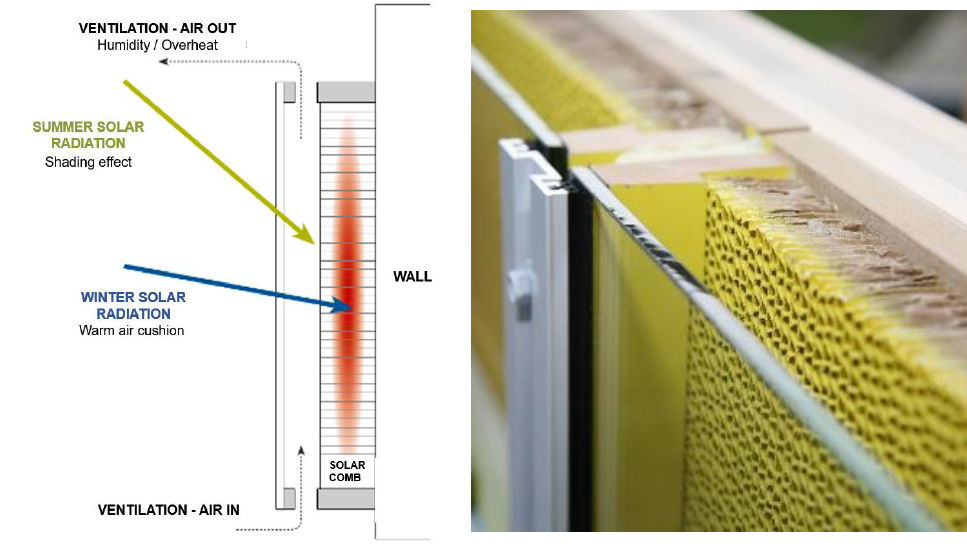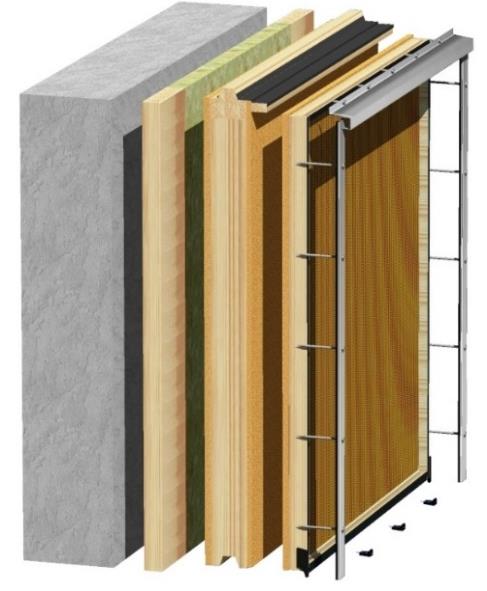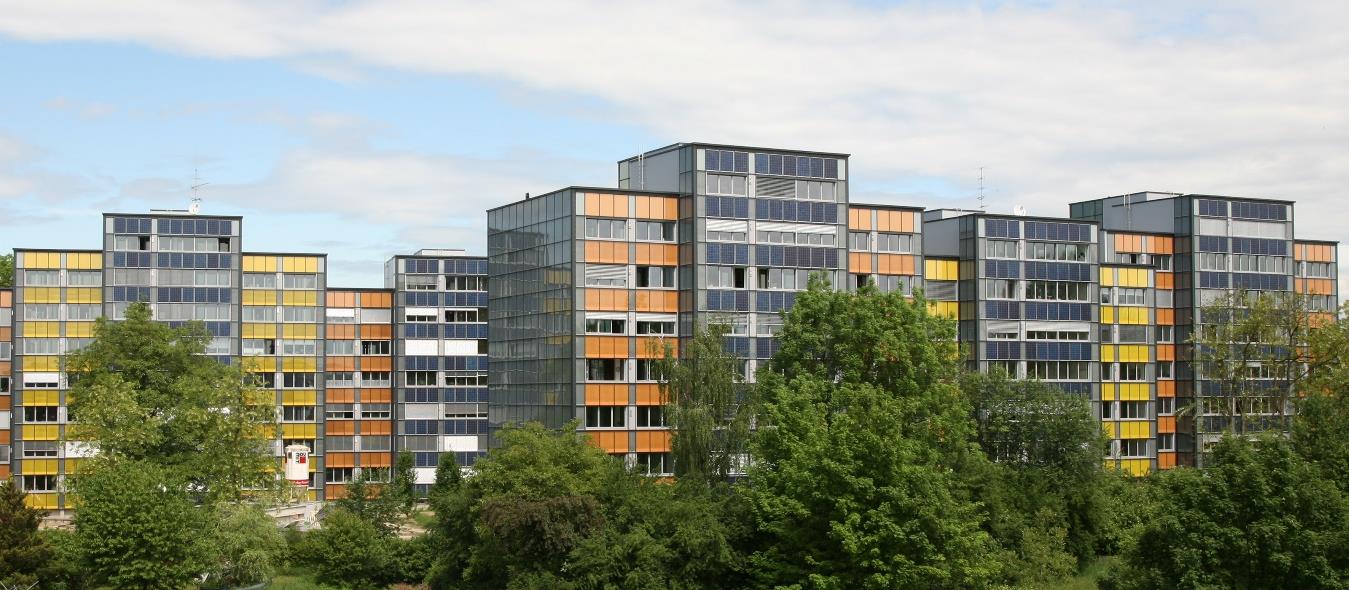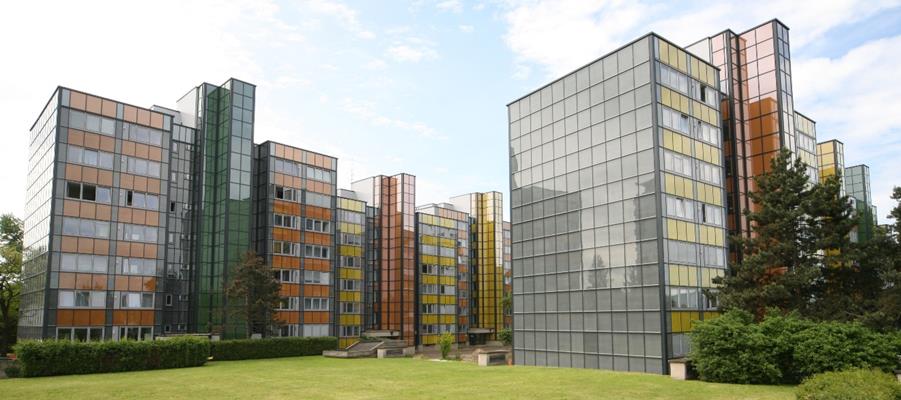Solar Gains Control Systems
Commercial Systems
GAP: Skin Facade
By Johann Aschauer, GAP Solutions GmbH, Austria
Product Description
Brief Concept Description
GAP Solutions is dedicated to the development and implementation of innovative, sustainable and value-enhancing passive solar system solutions for residential constructions, such as the GAP:skin façade shown in Figure 57. This prefabricated solar façade system integrates a honeycomb-structured panel to passively control the transmission of the solar radiation and keep the house warm in winter and pleasantly cool in summer. The honeycomb panel is made of cellulose (translucent thermal insulation, 100% biodegradable) and its shape is modelled after honeycombs from nature.
The honeycomb makes use of the position of the sun and the solar angles to regulate the indoor climate. The low winter sun penetrates in depth in the solar honeycomb structure and enables the formation of small warm air cushions. In this way, the temperature difference between the living space and the thermal buffer zone out of the existing wall is practically balanced out and the heat losses through the wall are greatly reduced. In summer, instead, the structure of the solar honeycomb shades itself with the high position of the sun, preventing the sun rays to penetrate the honeycomb structure. A retro-ventilated glass pane is mounted in front of the honeycomb to protect the module from weather and mechanical damages and allow the dissipation of humidity and overheat by natural convection.
The potential use of this system is enormous as it suited to residential buildings and hotels new construction and retrofit.

Figure 57. Schematic drawing (left) and view (right) of the GAP:skin façade.
Architectural and Technological Integration into the Envelope
GAP:skin façade elements are prefabricated and can be easily installed on a timber substructure that is then applied to the existing wall. In the final configuration (Figure 58), the outer layer is a glass pane mounted on a wooden frame with aluminium fixings. This frame hosts also the honeycomb panel, which is placed so that a small air gap is left between the glass pane and the panel. The cavity is not sealed, but it is slightly ventilated thanks to the openings left on the top and on the bottom sections of the façade module. The frame is fixed to a levelling layer constituted of a wooden substructure, which is turn fixed to the masonry structure.
GAP:skin is a low-tech system that does not have moving parts or active controls and thus has the lowest maintenance and repair costs.

Figure 58. Schematic drawings of the composing layers of GAP:skin façade.
Integration into the Building: System and Comfort
With the installation of GAP:skin façade system, it is possible to achieve several benefits such as an improved quality and appearance of the envelope, an extension of the life of the building and higher comfort for the tenants. Moreover, it is possible to achieve large reductions of the space heating demand due to the improved thermal insulation and the honeycomb structure. The lower energy demand results into lower energy bills but also into the possibility of reducing the size of the heating system, which alone can be enough to finance the investment. In this new paradigm, a shift in costs from building services to structural engineering is realized.
Aside economics and energy considerations, one of the main advantages of GAP:skin is that the assembly of the façade system can be carried out from the outside so that the residents do not have to leave their apartments during the refurbishment process. This means that the burden on tenants is kept to the minimum.
As an example, GAP:skin was implemented in the renovation of a residential complex in Gratz (Austria) in 2014. The project involved the renovation of multiple buildings with poor pre-renovation energy performance (i.e. uninsulated walls, important thermal bridges and a central gas-fired heating), corresponding to standard for residential building up to the 1980s.
Here, the retrofit intervention enabled to reduce the final energy consumption for space heating and domestic hot water preparation from approx. 135 kWh/m²a to approx. 8 kWh/m²a, which corresponds to a percentage energy consumption reduction of about 94%. GAP Solutions and Energie Service were responsible for conception, planning and construction supervision and about 10000 m2 of GAP:skin were installed. Savings in operating costs for heating and domestic hot water of around € 100,000 per year could be realized (base price level 2011/12).

Figure 59. Application of GAP:skin in a building complex (view from South) in Graz, Austria. Source: GAP Solutions.

Figure 60. Application of GAP:skin in a building complex (view from North) in Graz, Austria. Source: GAP Solutions.
SWOT Analysis
Strengths
- Higher tenants’ comfort and energy savings are achieve
- Low Life Cycle Costs
- The façade system is available in any colour
- The durability of the solution is guaranteed by the choice of materials (glass/aluminium on the outside and wood/wood-like materials on the inside)
- The high degree of prefabrication allows an easy installation on-site and higher reliability
- The façade module structure is diffusion-open (dehumidifying effect)
- It is a passive, low-tech system with no moving parts and low maintenance requirements
- Environmentally sustainable: easy recyclability / separability of materials and high wood content
- Maturity level: more than 20 years in use, more than 2000 residential units renovated or newly built with high satisfaction of customers, tenants and investors
Weaknesses
- No compatibility with listed facades
- There is a (current) limit on the maximum height where this solution can be applied (alternatives are in preparation)
- There is a higher investment costs with respect to traditional retrofits interventions, although the advantages at LCC level are clear
Opportunity
- The goals of European Union are pushing toward solutions that aim to achieve higher energy efficiency
- There is a new awareness for environmental issues that can reward sustainable solutions
- The buildings’ energy load is reduced to a point where the remaining load can be easily covered with RES technologies as PV
- National and international requirements for buildings’ and envelope energy performance can be easily met
- The market for this solution is very large
Threats
- There are no competitors, except for the traditional envelope retrofit systems
Lessons Learned
- Overheating of the house in summer and heat losses during winter can be prevented with a simple and low-tech façade.
- Solar facades should be planned to be as maintenance-free, stable and durable as possible.
- The building technology can be completely re-thought, as the energy demand is much lower
- Separability of components and recyclability of individual materials are relevant issues.
Further Reading
Further reading The building stock is a major cause of CO2 emissions. Europe has already been built - that is why the transition of Europe to a CO2-free building management must start there. The technological implementation has been realized for many years in best practice examples. Refurbishment of buildings is not a matter of financial resources or affordability - the GAP solutions show quite clearly that the reduction of energy costs can bear the financing of plus-energy renovations alone. It depends therefore only on the insight and good will of the acting persons / institutions / financial institutions / up to the politically responsible ones. There is still a number of barriers to get rid of. For example, all-inclusive rental agreements covering the cost of space heating, domestic hot water and household electricity.
More information on Photovoltaic Water Solution is available here: Passive House Renovation Graz, facadeintegrated DC-based hot water preheating, final report: Reports from Energy and Environmental Research 00/2010 • https://nachhaltigwirtschaften.at/de/hdz/projekte/photovoltaik-water-solution.php • https://nachhaltigwirtschaften.at/de/hdz/projekte/wohnhaussanierung-auf-passivhausstandardmakartstrasse-linz.php
Company Website: www.gap-solutions.at